Bar spread and how it works on horses
We are no longer building saddle trees, but we have two videos about how Western saddles fit horses available on our westernsaddlefit.com website.
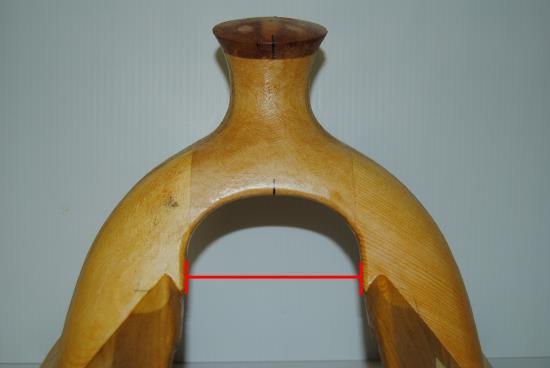
We’ve been in this business long enough now to see some changes in the industry and in the relative numbers of horses of different sizes and shapes. One of the things we have seen change over the years is the percentage of orders with different bar spreads. So I started to write about that for a specific reason (explained at the end) and then things just expanded from there…
Definition time
Bar spread is the width between the bars. It can also be called bar width, though that can be confused with bar depth. We measure this at the back of the fork, and the hand hole width defines the bar spread on out trees. This page explains why we don’t use gullet width.
What do the differences look like on the trees?
When Rod first started out, he was told 3 ¾” hand hole width was the standard “typical western ranch horse” size to use. This was what Julian Tubb (the saddle and tree maker who taught Rod to build trees) had been using in the 1980s and it was working really well on Canadian and north western US ranch horses. Ninety degrees was the standard bar angle as well. This is the fit in both our personal Tubb saddles, bought in the late 80’s and 1990.
Fortuitously, I happen to have pictures of 8" wide Wade trees in all the different hand hole widths, so you get to see some of the effect that fit has on the look of the fork as well.
Very quickly it became apparent that 3 ¾” was too narrow for the majority of ranch horses in the late 1990s. A 4” hand hole width soon became the norm and is still the most common width we make – but not by much anymore…
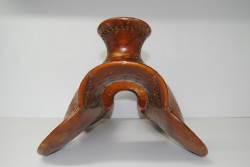 |
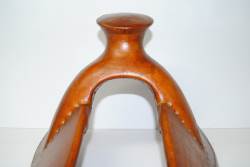 |
Over the years, horses seem to have been getting larger. Not necessarily flatter angled, but wider bodied. We now have more customers ordering 4 ¼” wide hand holes to go on working ranch horses. While a lot have a wider bar angle, the saddle makers building for working ranches in western Canada and the US northwest are often keeping the 90 degree bar angle (the tree in these pictures has a 90 degree bar angle), but are spreading the bars wider apart because the horses are just that much bigger.
We have even built a few trees with a 4 ½” wide hand hole for really wide horses (draft style), and the bar angles on these are often wider. This one is 98 degrees, which is very wide. We also make this width for some arena ropers who like to use a lot of padding. We have also made some pack trees this wide when they were to be used on big, heavy horses with a lot of padding.
And we have built a very few with 3 ½” wide hand holes for really narrow horses, but most still have been the 90 degree angle, as in these pictures. We have made them with an 87 degree bar angle too.
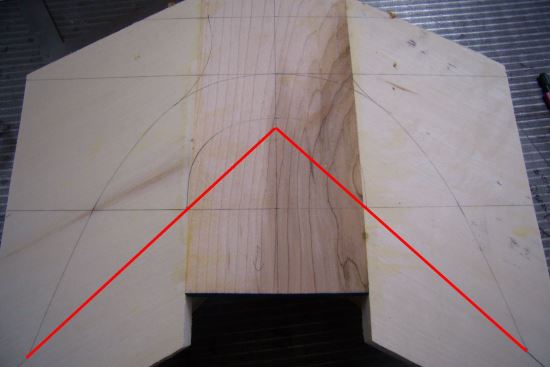
You can see that the bar angle is related but separate. Generally in off the rack trees, as the width increases, so does the angle of the bars, but that isn’t the way it has to be. Bar angle and bar spread are two independent things. Here we are just talking about the width between the bars. (Note – to explain why the picture above doesn’t show an “angle” drawn on the front of a finished tree, this page explains why the numbers are meaningless, and point #2 on this page shows you why you can’t measure it.)
What does this look like in terms of the horses they fit?
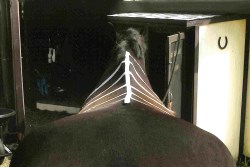 |
A 3 ½” hand hole width is used on a very narrow withered horse. We often tend to think of straight thoroughbreds when we think this narrow, but neither of these horses are TBs, though we have built trees this narrow for TBs. The bay is a Warmblood and the grey is an Egyptian Arabian. For those of us used to basic quarter horse types, these are extremely narrow horses, but they are the norm in some segments of the equine industry and in some countries or parts of North America. That said, I counted and we have built a grand total of nine normal riding trees with this fit. In the Dennis Lane system, generally the S4 card at the A position fits these horses pretty well. (We use the A position on the Dennis Lane system to help us set our bar width and angle. The twist, and therefore the angle farther back, varies depending on body type.)
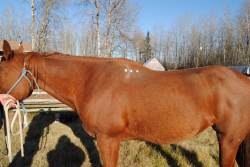 |
The 3 ¾” hand hole width that used to be the norm for Canadian ranch horses fits an in-shape horse with a well defined wither and wither pocket. These horses tend to be the rangier style QH, appendix QH and horses with a bit of TB influence somewhere in their background. So while these horses have a slightly narrower wither than many horses these days, they are still large bodied horses. Although we have a relatively small sample of the equine world in our saddle tree database, we see a higher percentage of this type of horse in the east than we do in the west. Interesting… Generally, the S5 and S6 cards fit these horses at the A position in the DL system, and a 90 degree bar angle works well on them.
However, we have found that the 3 ¾” hand hole width also works well for some small bodied horses. They don’t have a narrower wither relative to their body size. They are just small over all, their backs are not very wide and they don’t need a lot of width between the bars. Again, bar angle is separate from bar spread, so these horses can have quite the range of DL cards that fit their shape at the A position. Their shape there can vary from quite steep to quite flat. This is why we ask for pictures with the cards in place. We can see the size of the card relative to the size of the horse, and that helps us determine bar spread. We have made some of these trees with a wider angle to fit the shape of the withers while still keeping the bar spread at 3 ¾” wide to fit the narrower body.
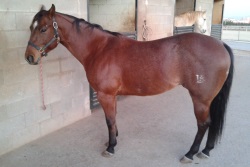 |
If we had to find the most common combination of bar width and angle we built, this would still be it – 4” hand hole width and 90 degree bar angle. The horses pictured here are pretty typical of the back that this conformation would fit. They are middle of the road, not bulgy but not narrow withered horses. A pretty common conformation of horse, in our part of the world anyway. In the DL system, these horses generally measure S7, D4, and D5 at the A position.
However, we have also used this hand hole width for horses with different angles (and therefore different DL card numbers than above) but whose bodies would fit the bar spread. For example, here is a Norwegian Fjord who is not a large horse, but who is a very flat angled horse. The tree we built was 4” at the hand hole to fit his body width, but 95 degrees to fit his flatter back. You can see how well the tree sits on his back. So again, width and angle are two independent, yet related, things and we have to consider both when we are building trees, especially for the more unusual body types, such as this one.
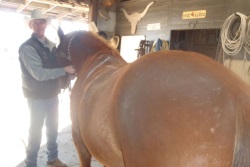 |
The horses we fit with 4 ¼” hand hole widths are also very common. In fact, we would say this body type may even be the “norm” in the southern US and other areas with more foundation QH influence and less TB influence in their background. They are also becoming more of the norm in more western parts of both Canada and the US. These are the horses that are often described as “stoutly built”. They have broader withers and are just bigger bodied horses over all. They measure D6 and up at the A position on the DL card system, with the angle getting wider as the card size increases.
And here is one that could use a 4 ½” hand hole width. This is purebred Clydesdale mare that the owners use as a riding horse. The saddle maker in the cowboy hat is 6 feet tall - without the hat – so you can see the shear size of this horse. She can use the bars being spread apart quite a ways as she has the breadth of back to handle that. We saw this horse before the DL system was available, so we don’t know what she would measure. She would be either a D9, D10 or likely even be beyond the DL system at the A position. I'm sure she is wider than the system allows for farther back. (We eventually found that you can use the cards at different positions than they are designed for if the horse is outside the sizes in the system. However, you have to make sure that the tree maker knows which cards you used!!)
So what happens if you the get spread wrong?
Here’s an example of a 4 ¼” hand hole width at 93 degree tree on a horse that could use a 3 ¾” x 90. The saddle maker was out looking at these horses and the tree he had on hand was 4 ¼” x 93 degree. You can see how it is tilted forward because it is just too wide. If the bars are spread too far apart for the body type you are trying to fit, there is just not enough horse under the front bar pads so the tree falls forward till it hits something to stop it - either somewhere along the top of the bars or the withers themselves. And this tilting affects not only the front. Look at how it is lifting off at the back end as well. This is all because it is too wide in both hand hole width and bar angle.
It is harder to see when a tree is too narrow for a horse because they don’t usually look too tipped back and often even the edges still look OK, depending on how they are shaped. But when you look down from inside the tree you can see how little bar is in contact with the horse. I’ve written about that more in a previous post you can read here so I won’t repeat it again.
So, what prompted this dissertation today? Well, I posted a tree we had for sale. It was a 3 ¾” hand hole width with a 90 degree bar angle and our normal amount of rock. I wanted to explain more about what type of horses it would work on, and the idea kind of grew from there…
(Here's a post where you can see what you are feeling for under a finished saddle.)
